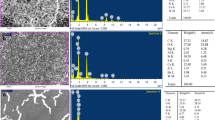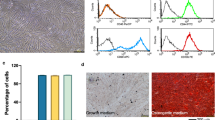Abstract
Mineral trioxide aggregate (MTA) is considered a pulp-capping agent of choice, but has the drawback of a long setting time. This study aimed to assess two different types of calcium-silicate cements as pulp-capping agents, by investigating their in vitro cytotoxicity and angiogenic effects in human pulp cells. ProRoot MTA, Endocem Zr, and Retro MTA were prepared as set or freshly mixed pellets. Human pulp-derived cells were grown in direct contact with these three cements, Dycal, or no cement, for 7 days. Initial cell attachment, viability, calcium release, and the levels of vascular endothelial growth factor (VEGF), angiogenin, and basic fibroblast growth factor (FGF-2) were evaluated statistically using a linear mixed model (P < 0.05). The biocompatibility of Retro MTA was similar to those of the control and ProRoot MTA. Endocem Zr groups showed fewer and more rounded cells after a 3-day culture; however, the initial cytotoxicity appeared transient. All test materials showed significant increases in calcium concentration compared with the control group (P < 0.05). VEGF and angiogenin levels in ProRoot MTA and Retro MTA groups were significantly higher than those in the Endocem Zr group (P < 0.05). FGF-2 levels were not significantly different between groups (P > 0.05). We demonstrate that Retro MTA, which has a short setting time, has similar biocompatibility and angiogenic effects on human pulp cells, and can therefore potentially be as effective in pulp capping as ProRoot MTA. Endocem Zr showed intermittent cytotoxicity and elicited lower levels of VEGF and angiogenin expression.





Similar content being viewed by others
References
Torabinejad M, Hong CU, Lee SJ, et al. Investigation of mineral trioxide aggregate for root-end filling in dogs. J Endod. 1995;21:603–8.
Torabinejad M, Pitt Ford TR, McKendry DJ et al. Histologic assessment of mineral trioxide aggregate as a root-end filling in monkeys. J Endod. 1997; 23:225–8.
Zhu Q, Haglund R, Safavi KE, et al. Adhesion of human osteoblasts on root-end filling materials. J Endod. 2000;26:404–6.
Balto HA. Attachment and morphological behavior of human periodontal ligament fibroblasts to mineral trioxide aggregate: a scanning electron microscope study. J Endod. 2004;30:25–9.
Baek SH, Plenk H Jr, Kim S. Periapical tissue responses and cementum regeneration with amalgam, SuperEBA, and MTA as root-end filling materials. J Endod. 2005;31:444–9.
Cho SY, Seo DG, Lee SJ, et al. Prognostic factors for clinical outcomes according to time after direct pulp capping. J Endod. 2013;39:327–31.
Hilton TJ, Ferracane JL, Mancl L, et al. Comparison of CaOH with MTA for direct pulp capping: a PBRN randomized clinical trial. J Dent Res. 2013;92:16S–22S.
Choi Y, Park SJ, Lee SH, et al. Biological effects and washout resistance of a newly developed fast-setting pozzolan cement. J Endod. 2013;39:467–72.
Li Q, Deakon AD, Coleman NJ. The impact of zirconium oxide nanoparticles on the hydration chemistry and biocompatibility of white Portland cement. Dent Mater J. 2013;32:808–15.
Han L, Kodama S, Okiji T. Evaluation of calcium-releasing and apatite-forming abilities of fast-setting calcium silicate-based endodontic materials. Int Endod J. 2015 (in press). doi:10.111/iej.12290.
Paranjpe A, Cacalano NA, Hume WR, et al. N-acetylcysteine protects dental pulp stromal cells from HEMA-induced apoptosis by inducing differentiation of the cells. Free Radic Biol Med. 2007;43:1394–408.
Schroder U. Effects of calcium hydroxide-containing pulp-capping agents on pulp cell migration, proliferation, and differentiation. J Dent Res. 1985;64:541–8.
Tada H, Nemoto E, Kanaya S, et al. Elevated extracellular calcium increases expression of bone morphogenetic protein-2 gene via a calcium channel and ERK pathway in human dental pulp cells. Biochem Biophysic Res Commun. 2010;394:1093–7.
Peng W, Liu W, Zhai W, et al. Effect of tricalcium silicate on the proliferation and odontogenic differentiation of human dental pulp cells. J Endod. 2011;37:1240–6.
Du R, Wu T, Liu W, et al. Role of the extracellular signal-regulated kinase 1/2 pathway in driving tricalcium silicate-induced proliferation and biomineralization of human dental pulp cells in vitro. J Endod. 2013;39:1023–9.
Park SJ, Heo SM, Hong SO et al. Odontogenic Effect of a fast-setting Pozzolan-based pulp capping material. J Endod. 2015 (in press) doi:10.1016/j.joen.2014.01.004.
El Karim IA, Linden GJ, Irwin CR, et al. Neuropeptides regulate expression of angiogenic growth factors in human dental pulp fibroblasts. J Endod. 2009;35:829–33.
Chu SC, Tsai CH, Yang SF, et al. Induction of vascular endothelial growth factor gene expression by proinflammatory cytokines in human pulp and gingival fibroblasts. J Endod. 2004;30:704–7.
Tran-Hung L, Laurent P, Camps J, et al. Quantification of angiogenic growth factors released by human dental cells after injury. Arch Oral Biol. 2008;53:9–13.
Chung CR, Kim HN, Park Y, et al. Morphological evaluation during in vitro chondrogenesis of dental pulp stromal cells. Restor Dent Endod. 2012;37:34–40.
Chung CR, Kim E, Shin SJ. Biocompatibility of bioaggregate cement on human pulp and periodontal ligament (PDL) derived cells. J Korean Acad Conserv Dent. 2010; 35:473–8.
Song M, Yoon TS, Kim SY, et al. Cytotoxicity of newly developed pozzolan cement and other root-end filling materials on human periodontal ligament cell. Restor Dent Endod. 2014;39:39–44.
de Souza Costa CA, Hebling J, Garcia-Godoy F et al. In vitro cytotoxicity of five glass-ionomer cements. Biomater. 2003; 24:3853–8.
Lee BN, Son HJ, Noh HJ, et al. Cytotoxicity of newly developed ortho MTA root-end filling materials. J Endod. 2012;38:1627–30.
Kum KY, Zhu Q, Safavi K, et al. Analysis of six heavy metals in ortho mineral trioxide aggregate and ProRoot mineral trioxide aggregate by inductively coupled plasma-optical emission spectrometry. Aust Endod J. 2013;39:126–30.
Chang SW, Lee SY, Ann HJ et al. Effects of calcium silicate endodontic cements on biocompatibility and mineralization-inducing potentials in human dental pulp cells. J Endod. 2015 (in press). doi:10.1016/j/joen.2014.01.001.
Lopez-Cazaux S, Bluteau G, Magne D, et al. Culture medium modulates the behaviour of human dental pulp-derived cells: technical note. Euro Cell Mater. 2006;11:35–42.
Farber JL. The role of calcium in cell death. Life Sci. 1981;29:1289–95.
Folkman J, Shing Y. Angiogenesis. J Biol Chem. 1992;267:10931–4.
Ilic J, Radovic K, Roganovic J, et al. The levels of vascular endothelial growth factor and bone morphogenetic protein 2 in dental pulp tissue of healthy and diabetic patients. J Endod. 2012;38:764–8.
I DA, Nargi E, Mastrangelo F et al. Vascular endothelial growth factor enhances in vitro proliferation and osteogenic differentiation of human dental pulp stem cells. J Biol Reg Homeostat Agent. 2011; 25:57–69.
Paranjpe A, Zhang H, Johnson JD. Effects of mineral trioxide aggregate on human dental pulp cells after pulp-capping procedures. J Endod. 2010;36:1042–7.
Shiba H, Nakamura S, Shirakawa M, et al. Effects of basic fibroblast growth factor on proliferation, the expression of osteonectin (SPARC) and alkaline phosphatase, and calcification in cultures of human pulp cells. Develop Biol. 1995;170:457–66.
Acknowledgments
This study was supported by a Grant from the Korean Health Care Technology R&D Project, Ministry of Health Welfare & Family Affairs, Republic of Korea (A084458). The authors want to deliver a special thanks to Youngju Oh for her help about laboratory works and Hannah You for statistical analysis.
Conflict of interest
The authors deny any conflicts of interest.
Author information
Authors and Affiliations
Corresponding author
Rights and permissions
About this article
Cite this article
Chung, C.J., Kim, E., Song, M. et al. Effects of two fast-setting calcium-silicate cements on cell viability and angiogenic factor release in human pulp-derived cells. Odontology 104, 143–151 (2016). https://doi.org/10.1007/s10266-015-0194-5
Received:
Accepted:
Published:
Issue Date:
DOI: https://doi.org/10.1007/s10266-015-0194-5




